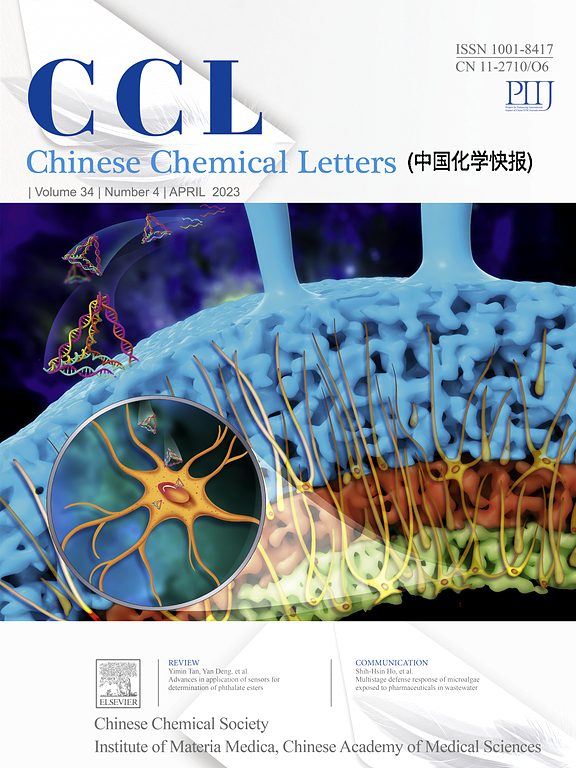Correlating vacancy-defect density with CO2 activation for promoted CO2 methanation over CsPbBr3 photocatalyst
IF 9.4
1区 化学
Q1 CHEMISTRY, MULTIDISCIPLINARY
引用次数: 0
Abstract
Constructing vacancy-decorated metal halide perovskites (MHPs) have emerged as promising pathway to enhance photocatalytic activity and selectivity for solar CO2 reduction. However, the controllable construction of vacancy defects is still challenging, and our understanding of the roles of these defects, particularly their effects on the adsorption activation of surface reaction molecules, is still insufficient. Herein, we elaborately designed and synthesized adjustable Br vacancies in CsPbBr3 catalysts by manipulating the dissolution and recrystallization speed of precursors during the ball milling process using solvents with gradient polarities. We found that the Br vacancies could promote the charge separation, while having slight influence on the band structure of CsPbBr3. More importantly, temperature-programmed desorption results combined with theoretical calculations revealed that Br vacancies can significantly enhance the adsorption of CO2 and CO on the surface, specifically increasing the adsorption strength between CO and the active sites. This finding provides a substantial opportunity for achieving high activity and selectivity in photocatalytic CO2 methanation. Accordingly, a high rate of CO2 photoreduction to CH4 up to 17.94 ± 0.81 μmol g-1 h-1 along with superior selectivity of 95.8% were acquired for CsPbBr3![]() HX featuring with the richest Br vacancy defects, which is 18.9-fold compared that of CsPbBr3
HX featuring with the richest Br vacancy defects, which is 18.9-fold compared that of CsPbBr3![]() CAN with the lowest Br vacancy defects. This investigation deepens insights into action mechanism of defects on halide perovskites catalysts, offering a novel strategy for the high-effective conversion of CO2 into valuable products.
CAN with the lowest Br vacancy defects. This investigation deepens insights into action mechanism of defects on halide perovskites catalysts, offering a novel strategy for the high-effective conversion of CO2 into valuable products.

CsPbBr3光催化剂上促进CO2甲烷化的空位缺陷密度与CO2活化的关系
构建空位修饰的金属卤化物钙钛矿(MHPs)是提高太阳能CO2还原光催化活性和选择性的有希望的途径。然而,空位缺陷的可控构建仍然具有挑战性,我们对这些缺陷的作用,特别是它们对表面反应分子吸附活化的影响的认识仍然不足。本文采用梯度极性溶剂,通过控制前驱体在球磨过程中的溶解和再结晶速度,精心设计并合成了CsPbBr3催化剂中可调节的Br空位。我们发现Br空位可以促进电荷分离,而对CsPbBr3的能带结构影响不大。更重要的是,程序升温解吸结果与理论计算相结合表明,Br空位可以显著增强CO和CO2在表面的吸附,特别是增加CO与活性位点之间的吸附强度。这一发现为实现光催化CO2甲烷化的高活性和选择性提供了大量的机会。结果表明,CsPbBr3HX的CO2光还原率高达17.94 ±0.81 μmol g-1 h-1,选择性为95.8%,是Br空位缺陷最少的CsPbBr3CAN的18.9倍。该研究加深了对卤化物钙钛矿催化剂缺陷作用机理的认识,为二氧化碳高效转化为有价产品提供了新的策略。
本文章由计算机程序翻译,如有差异,请以英文原文为准。
求助全文
约1分钟内获得全文
求助全文
来源期刊

Chinese Chemical Letters
化学-化学综合
CiteScore
14.10
自引率
15.40%
发文量
8969
审稿时长
1.6 months
期刊介绍:
Chinese Chemical Letters (CCL) (ISSN 1001-8417) was founded in July 1990. The journal publishes preliminary accounts in the whole field of chemistry, including inorganic chemistry, organic chemistry, analytical chemistry, physical chemistry, polymer chemistry, applied chemistry, etc.Chinese Chemical Letters does not accept articles previously published or scheduled to be published. To verify originality, your article may be checked by the originality detection service CrossCheck.
 求助内容:
求助内容: 应助结果提醒方式:
应助结果提醒方式:


